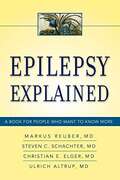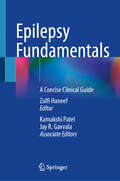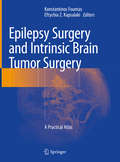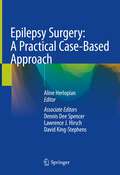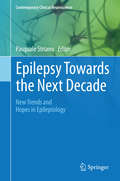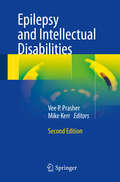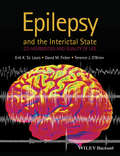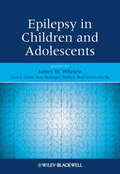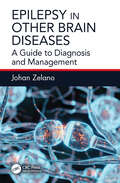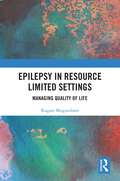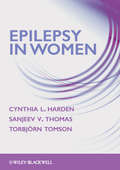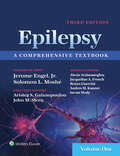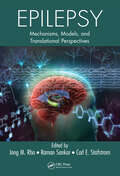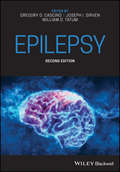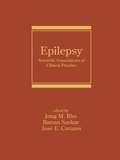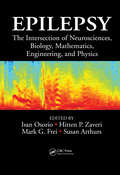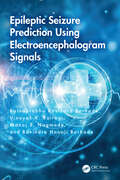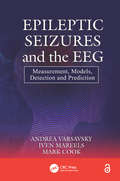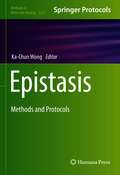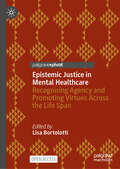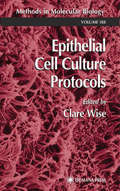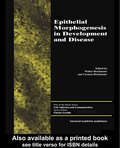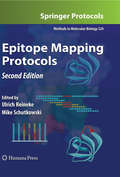- Table View
- List View
Epilepsy Case Studies: Pearls for Patient Care
by William O. Tatum Joseph I. Sirven Gregory D. CascinoThis book presents a case based approach to epilepsy management in both diagnostic challenges and treatment of complex cases. Cases reflect “real life” patient scenarios that practitioners encounter with up-to-date terminology and treatment approaches.With 51 chapters, the book presents 51 unique, nuanced cases. Beginning with an initial presentation of a case history, the book opens with a basis for drawing in multiple aspects in the treatment of patients with epilepsy. Each chapter is organized into a clinical history, physical examination results, and ancillary testing to concentrate on differential diagnosis and focus on a definitive procedural approach to the final diagnosis. Subsequent information about the condition expands on the knowledge of the clinical features to a solution of common patient clinical scenarios as it affects people with epilepsy.A comprehensive successor edition, Epilepsy Case Studies is an invaluable resource to clinicians ranging from those looking for a quick review of a topic present in the table of contents, to those crossing disciplines into medical areas where seizures are a symptom of disordered or dysfunctional brain.
Epilepsy Explained: A Book for People Who Want to Know More
by Steven C. Schachter Christian E. Elger Markus Reuber Ulrich AltrupIn the last five years, approximately 2.7 million people have been treated for epilepsy and it is estimated that as much as one in one-hundred of the world's population will develop epilepsy during their lifetime. It is further estimated that 60 million people worldwide have epilepsy and in the United States alone, between seventy to eighty thousand people are newly diagnosed each year. Despite being such a common problem, most people know little about the disorder and people with epilepsy feel stigmatized. Filled with illustrations on almost every page and boasting an attractive and stimulating layout, Epilepsy Explained offers a wealth of crystal clear information on epilepsy, intended for patients, family members, friends, and caregivers. This down-to-earth book is divided into easy-to-digest sections that address such fundamental questions as what epilepsy is, what happens in different types of epileptic seizures, how epilepsy is diagnosed, and how seizures are treated. The authors include much-needed information on numerous topics, including living successfully with seizures, patients rights, and current drugs used to treat epilepsy--all described with directness and clarity, with many real-life examples that shed light on how the topic under discussion affects people with epilepsy. The book includes information for particular groups of readers such as women, children, and teens. It has an easy-to-follow organization, is clearly structured and has a detailed index and glossary, allowing readers to easily find specific information pertaining to their condition. Written by physicians who work daily with epilepsy, this clear and engaging book provides people with the knowledge they need to make informed choices about their illness.
Epilepsy Fundamentals: A Concise Clinical Guide
by Zulfi HaneefThere is a considerable need for a concise handbook available for the student of epilepsy. Epilepsy is a rapidly evolving field and the available books are large, unwieldy and infrequently updated. This book fills this need by providing a concise review on the evolving field of epilepsy. It's aimed for the medical student or resident rotating through epilepsy and EEG, a fellow preparing for the ABPN epilepsy board, or an epilepsy specialist seeking to quickly brush up your knowledge in the field. Chapters cover the critical areas of classification, EEG, clinical features, medication management, surgical management, and other topics. This books brings the latest research and best practices together into a streamlined resource, offering a personal touch stemming from the experience of academic epileptologists.
Epilepsy Surgery and Intrinsic Brain Tumor Surgery: A Practical Atlas
by Konstantinos Fountas Eftychia Z. KapsalakiThis book provides a comprehensive and practical guide for the safe and efficient management of patients with intrinsic brain tumors and medically intractable epilepsy. It presents in an easily understandable way the preoperative evaluation of these patients, starting from the clinical interpretation of conventional anatomical MR imaging and analyses the clinical significance of newer MR based imaging techniques such as diffusion and perfusion imaging. It demonstrates with clarity the role of MR spectroscopy and fractional anisotropy and diffusion tensor imaging in the preoperative assessment of these patients and how this data can be incorporated into the surgical planning. This book is aimed at neurosurgeons, neuroradiologists, neurologists, and epileptologists, and may also be of interest to neuropsychologists, neurophysiologists, radiation oncologists, and medical physicists.
Epilepsy Surgery: A Practical Case-Based Approach
by Lawrence J. Hirsch Aline Herlopian Dennis Dee Spencer David King-StephensThis collection of epilepsy surgical cases illustrates patients with straightforward and challenging pharmacoresistant epilepsy. These cases convey the advancements, investigative strategies, past and modern surgical tools, and sophisticated state-of-the-art of epilepsy surgery and its disciplines. This textbook is organized into four major sections that parallel the contemporary FDA-approved and clinically applicable approaches: resective surgery, disconnection procedures, laser therapy, and neuromodulation. The chapters provide a case-based, interactive, and multidisciplinary integrative approach to pre-operative evaluation, data analysis, and surgical decision-making. In addition, we present alternative approaches to certain diagnostic tools, decision-making strategies, and surgical interventions.This textbook will provide trainees and clinicians with an exhaustive understanding of epilepsy surgery. Moreover, it will be an invaluable resource for preparation for the epilepsy board examination
Epilepsy Towards the Next Decade
by Pasquale StrianoA comprehensive collection of the most recent knowledge on the biological bases of various kinds of epilepsies and modern clinical approaches to their treatment. Epilepsy affects about 0. 5-1% of the world's population (about 50,000,000 individuals) and the main goal of its treatment is to eliminate seizures without creating side effects. Despite numerous advances in the treatment of epilepsy and the approval of several new antiepileptic drugs, about 30% of patients continue to experience recurrent seizures which are medically, physically, and/or socially disabling. The editor of this volume hopes that by bridging the gap between the fundamental biology of epilepsy and its clinical implications he might spur further research and treatment options.
Epilepsy and Intellectual Disabilities
by Vee P. Prasher Mike KerrThis second edition of a successful book provides updated clinical and research knowledge, including information on the licensing of new antiepileptic drugs. All chapters are updated to reflect present accepted practice. New chapters highlighting the importance of the genetic aspects of epilepsy, nonpharmacological treatments, and the impact of epilepsy on families and carers have been added. Ongoing developments in the general population, which will more likely than not become relevant to the intellectually disabled population, are discussed. The impact of epilepsy on the person themselves and their carers is acknowledged, and person-centred treatment programs with a multifaceted team approach are proposed. This book is aimed at physicians and residents in neurology and pediatrics, as well as other practitioners working with this population, such as neuropsychologists. Epilepsy and Intellectual Disabilities, Second Edition is recommended reading for all those caring for this important group of individuals.
Epilepsy and the Interictal State
by Terence J. O'Brien David M. Ficker Erik K. St LouisEpilepsy care traditionally focuses on seizures, yet for most epilepsy sufferers, other interictal factors such as mood, cognitive abilities, and treatment adverse effects most influence how they feel and function day to day.Epilepsy and the Interictal State is a practical and comprehensive text that covers quality of life issues, cognition and therapy, adverse effects of epilepsy treatments, mood state and psychiatric co-morbidity and general health aspects of epilepsy. Each chapter employs a standard structure providing background, epidemiology, pathophysiology, etiology, diagnosis, treatment, prognosis and further practical advice.From an international team of expert editors and contributors, Epilepsy and the Interictal State is a valuable resource for specialist epileptologists and neurologists, as well as for neurosurgeons, neurology nurses, psychiatrists, family physicians and general practitioners.
Epilepsy in Children and Adolescents
by Philip L. Pearl Yu-Tze Ng Amy L. Mcgregor James W. Wheless Dave F. ClarkeThis book provides the contemporary, caring guidance you need to diagnose and manage seizures in a young patient. Beginning with an overview of the classification of seizure syndromes, the authors take a practical approach to a common but complex clinical challenge. Aimed at both professionals and trainees in neurology, this book will also be a useful guide for all primary health professionals caring for pediatric patients with this condition. It is intended as a foundation for further study into pediatric epilepsy and to serve as a quick, up-to-date reference for the recognition, diagnosis, basic understanding, evaluation and management of this condition in children and adolescents.
Epilepsy in Other Brain Diseases: A Guide to Diagnosis and Management
by Johan ZelanoA substantial proportion of patients with other brain diseases like stroke, traumatic brain injury, and dementia will develop epilepsy. This book provides a clear and concise guide to the epidemiology and clinical research on epilepsy as it occurs in the context of other brain diseases.A better and more detailed understanding of the diseases related to the brain following decades of advances in neuroimaging, pathology, and neurophysiology have led to new insights into mechanisms leading to epilepsy. Advances in research on epilepsy in one brain disease are known to lead to an improved understanding of epilepsy in others. Advances in neurological care have resulted in patients with stroke, tumors, or infections surviving longer, with ensuing demands for long-term treatment, including epilepsy.A key message across the different chapters in the book is that epilepsy in other brain diseases should be managed just as ambitiously as any other epilepsy. Neurologists treating patients with brain disease will find this book accessible and practical. It will ensure a deeper understanding of acquired epilepsy among clinicians.
Epilepsy in Resource Limited Settings: Managing Quality of Life
by Rugare MugumbateFocused on the understandings and impacts of epilepsy in resource-limited settings, particularly those in the Global South, this important book provides a thorough examination of how the condition can be managed to promote better quality of life.The book is informed by global initiatives, including the Intersectoral Global Action Plan (IGAP) on epilepsy established by the World Health Organisation in 2022. The first two chapters are centred on two broad but competing perspectives on epilepsy, the spiritual and the biological, which are followed by chapters covering the determinants and prevention of epilepsy, and first aid, guidance and counselling. The book moves on to outline the disadvantages, impacts and challenges of epilepsy, as well as initiatives to address the condition at regional and global levels, spotlighting responses in Africa, Asia and the Pacific, the Caribbean, the Middle East and North Africa, and Latin America. The final section of the book focuses on social management, individual resilience and social services, with a concluding chapter outlining a new Integrative Model for Managing Epilepsy (IMME).Written by an author with extensive experience designing and leading epilepsy programmes both internationally and in sub-Saharan Africa, this book will interest Social Work, Public Health, Nursing, Medical, Counselling, Community Health scholars, students and practitioners.
Epilepsy in Women: The Scientific Basis For Clinical Management (Issn Ser. #Volume 83)
by Cynthia L. HardenEpilepsy requires careful management and monitoring through a woman’s life Epilepsy is a complex disease. The hormonal changes women experience, both day-to-day menstrual fluctuations and the longer waxes and wanings of a reproductive lifetime, make the management of epilepsy even more complicated. At some point, the well-being of a second person, a fetus, might also have to be taken into account. Epilepsy in Women provides a detailed guide to this challenge. The wide-ranging approach encompasses all aspects of a woman’s life including: Social and psychological impacts The impact in reproductive life Contraception Pregnancy Fetal health and long term developmental outcomes Lactation Menopause Each practical chapter begins and ends with a case study that demonstrates the more general challenge. The authors develop themes to provide clinical guidance based on evidence and experience. Written and edited by an international cast of experts, Epilepsy in Women provides crucial tips and recommendations for neurologists and gynecologists who need to be aware of the subtle effects of epilepsy on woman’s life.
Epilepsy: A Comprehensive Textbook
by Solomon L. Moshé Jerome Engel JrAuthoritative and updated, Epilepsy: A Comprehensive Textbook, 3rd Edition, contains 365 chapters that cover the full spectrum of relevant topics in biology, physiology, and clinical information, from molecular biology to public health concerns in developing countries. Written by world-renowned authorities and expertly edited by epileptologists Drs. Jerome Engel, Jr., Solomon L. Moshé, Aristea S. Galanopoulou, John M. Stern, Alexis Arzimanoglou, Jacqueline A. French, Renzo Guerrini, Andres M. Kanner, and Istvan Mody, this three-volume work includes detailed discussions of seizure types and epilepsy syndromes, relationships between physiology and clinical events, psychiatric and medical comorbidities, conditions that could be mistaken for epilepsy, and an increasing range of pharmacologic, surgical, and alternative therapies.
Epilepsy: Mechanisms, Models, and Translational Perspectives
by Jong M. Rho Raman SankarEpilepsy has afflicted humankind throughout recorded history; yet, it is only in the last half-century, that significant progress has been made in our basic understanding of the epileptic brain. Pivotal advances in drug development and surgical techniques, as well as the emergence of innovative approaches such as electrical stimulation of the nervo
Epilepsy: Pearls For Patient Care
by Gregory D CascinoDesigned to provide a comprehensive but accessible introduction to epilepsy and seizure disorders, Epilepsy, 2nd edition provides state-of-the-art information in a concise format useful to a wide audience, from neurology residents to epilepsy fellows and practitioners. This illustrated guide to the assessment, diagnosis, and treatment of epilepsy is a valuable resource enabling clinicians to stay on top of the latest recommendations for best practice
Epilepsy: Scientific Foundations of Clinical Practice
by Jong M. Rho Raman Sankar José E. CavazosThe most up-to-date reference on the topic, Epilepsy analyzes the most relevant research developments in parallel clinical issues impacting modern therapeutic regimens-defining the scientific basis of current clinical practices and posing a set of challenging questions and considerations that may impact the future of clinical epilepsy research and
Epilepsy: The Intersection of Neurosciences, Biology, Mathematics, Engineering, and Physics
by Ivan Osorio Hitten P. Zaveri Mark G. Frei Susan ArthursEpilepsy, one of the most prevalent neurological disorders, affects approximately 1% (greater than 60 million) of the world's population. In an estimated 20 million of these patients, seizures are not controlled even by multiple anti-seizure drugs, and are extremely difficult to predict. Epilepsy: The Intersection of Neurosciences, Biology, Mathema
Epileptic Seizure Prediction Using Electroencephalogram Signals
by Ratnaprabha Ravindra Borhade Vinayak K. Bairagi Manoj S. Nagmode Ravindra Honaji BorhadeThis book presents an innovative method of EEG-based feature extraction and classification of seizures using EEG signals. It describes the methodology required for EEG analysis, seizure detection, seizure prediction, and seizure classification. It contains a compilation of techniques described in the literature and emphasizes newly proposed techniques. The book includes a brief discussion of existing methods for epileptic seizure diagnosis and prediction and introduces new efficient methods specifically for seizure prediction. Focuses on the mathematical models and machine learning algorithms from a perspective of clinical deployment of EEG-based epileptic seizure prediction Discusses recent trends in seizure detection, prediction, and classification methodologies Provides engineering solutions to severity or risk analysis of detected seizures at remote places Presents wearable solutions to seizure prediction Includes details of the use of deep learning for epileptic seizure prediction using EEG This book acts as a reference for academicians and professionals who are working in the field of computational biomedical engineering and are interested in the domain of EEG-based disease prediction.
Epileptic Seizures and the EEG: Measurement, Models, Detection and Prediction
by Mark Cook Andrea Varsavsky Iven MareelsA study of epilepsy from an engineering perspective, this volume begins by summarizing the physiology and the fundamental ideas behind the measurement, analysis and modeling of the epileptic brain. It introduces the EEG and provides an explanation of the type of brain activity likely to register in EEG measurements, offering an overview of how these EEG records are and have been analyzed in the past. The book focuses on the problem of seizure detection and surveys the physiologically based dynamic models of brain activity. Finally, it addresses the fundamental question: can seizures be predicted? Based on the authors' extensive research, the book concludes by exploring a range of future possibilities in seizure prediction.
Epileptische Anfälle und Epilepsien im Erwachsenenalter: Diagnostik und Therapie
by Hermann Stefan Friedhelm C. Schmitt Martin HoltkampDas Buch bietet dem Behandler einen Überblick über die gängigen klinisch relevanten Konzepte sowie diagnostischen und therapeutischen Maßnahmen in der Epileptologie. Mit seinem praxisorientierten Aufbau befähigt das Werk dazu, dieses Wissen im klinischen Kontext direkt anzuwenden.Zahlreiche Kasuistiken beantworten über die Kapitel hinweg typische Fragen zu Differenzialdiagnostik, Therapie und sozialmedizinischen Aspekten. Bei den Therapien kommen sowohl medikamentöse als auch operative Ansätze zur Sprache. Ein ballastfreies Buch, geschrieben von Epilepsie-Experten aus Deutschland, Österreich und der Schweiz, das sich den konkreten klinischen Aspekten widmet und dabei die entsprechenden nationalen und internationalen Leitlinien berücksichtigt.
Epistasis: Methods and Protocols (Methods in Molecular Biology #2212)
by Ka-Chun WongThis volume explores methods and protocols for detecting epistasis from genetic data. Chapters provide methods and protocols demonstrating approaches to identify epistasis, genetic epistasis testing, genome-wide epistatic SNP networks, epistasis detection through machine learning, and complex interaction analysis using trigenic synthetic genetic array (τ-SGA). Written in the highly successful Methods in Molecular Biology series format, chapters include introductions to their respective topics, application details for both the expert and non-expert reader, and tips on troubleshooting and avoiding known pitfalls. Authoritative and cutting-edge, Epistasis: Methods and Protocols aims to ensure successful results in the further study of this vital field. "Simulating Evolution in Asexual Populations with Epistasis” is available open access under a Creative Commons Attribution 4.0 International License via link.springer.com.
Epistemic Justice in Mental Healthcare: Recognising Agency and Promoting Virtues Across the Life Span
by Lisa BortolottiThis open access book explores epistemic justice in mental healthcare, bringing together perspectives from psychologists, psychiatrists, philosophers, activists, and lived experience researchers. Through eight chapters, authors identify threats to the agency of people who hear voices, experience depression, have psychotic symptoms, live with dementia, are diagnosed with personality disorders, and face serious mental health issues while receiving palliative care. Considering the power asymmetries in clinical interactions, where patients are vulnerable and healthcare professionals are uniquely placed to offer support, this book reaffirms the importance of recognizing patients as agents and collaborators. Topics covered include trust in the therapeutic relationship, dignity at the end of life, the social dimension of health, stigma in an acute ward, the harm caused by biases and stereotypes, the role of clinical communication, and the promise of digital health. Students, academic researchers, practitioners, as well as mental health charities will benefit from this timely collection.
Epithelial Cell Culture Protocols
by Clare WiseWell-versed experimenters and clinical researchers share their best methods for establishing and maintaining epithelial cell cultures, for analyzing and studying their characteristics, and for using them to set up models of critical biological systems. The emphasis is on the analysis and assessment of epithelial cells, for example by looking at apoptosis and integrins, or by measuring membrane capacitance and confluence. Also described in step-by-step detail are co-culture techniques valuable in developing models for investigating many different in vitro systems, including the blood-brain barrier, drug uptake, and the interaction of epithelial cells with bacteria. Epithelial Cell Culture Protocols offers a step-by-step guide toward a deeper understanding of cellular and molecular mechanisms, as well as a set of robust techniques for specifically evaluating the nature and behavior of epithelial cells.
Epithelial Morphogenesis in Development and Disease
by Walter BirchmeierBringing together a series of articles on the structural, functional, and developmental characteristics of epithelia, this volume represents a timely and valuable contribution to a growing field of study.
Epitope Mapping Protocols
by Mike Schutkowski Ulrich ReinekeGiven the versatile utility of the determinination of epitopes, beneficial to a wide variety of scientists from immunologists to structural biologists to biotechnologists, the need for a thorough, state-of-the-art collection of experimental protocols is clear. In Epitope Mapping Protocols, Second Edition, expert contributors from a broad spectrum of scientific backgrounds update and expand the successful first edition with cutting-edge techniques and applications, including approaches to both antibody or B-cell epitope mapping and T-cell epitope mapping as well as a new section on the profiling of antibody signatures in biological fluids. Written in the popular Methods in Molecular BiologyTM series format, chapters include brief introductions to the topics, lists of the necessary materials and reagents, step-by-step, readily reproducible laboratory protocols, and Notes sections, which highlight tips on troubleshooting and avoiding known pitfalls. Comprehensive and up-to-date, Epitope Mapping Protocols, Second Edition is a reliable and valuable reference for all those who wish to understand and further investigate the diversifying field of epitope mapping.

